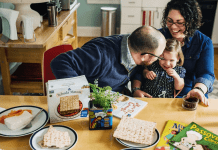My husband and I have walked into my late mother-in-law’s house for the last time.
We are in the process of settling her estate, including the sale of her house and disposition of everything in it.
From a hutch filled with china and crystal goblets to overflowing jewelry boxes and coin collections. And everything in between.
A lot in between.
Her clothes. The Notre Dame sweaters my late father-in-law was so fond of wearing. Her furniture. Furniture inherited from her mother-in-law, still in the same place in the garage where it was originally placed 30 some-odd years ago. My husband’s Cub Scout uniform. Christmas decorations. Lots and lots of Christmas decorations.
Every room, every closet, every shelf, every drawer. Full of stuff. A lifetime of stuff. Two lifetimes, if you count my father-in-law, who passed away 11 years ago.
What to Do With a Lifetime of Stuff
My mother-in-law was a neat and tidy housekeeper. But like many of us (myself included), she lived in a good-sized house with plenty of room to accommodate stuff. Things inherited from her parents and her in-laws. The broken vacuum cleaner waiting for repair in the back of the closet. Hundreds of books read once. You get the picture.
And the cost of disposing of all of that stuff? Having the estate sale company we hired go through every room, every closet, every drawer, separating the trash from the treasures, may cost more than will be generated at the eventual estate sale.
Her house has been transformed into a store, the estate sale company having cleverly arranged and displayed my mother-in-law’s possessions on tables in every room.
All of her possessions with any value, save the very few we kept, each with a tiny white price tag.
Losing your last surviving parent is hard enough. But being the arbiter of which of your parents’ and grandparents’ treasures get saved and which end up sold, donated, or in a landfill? gut-wrenching.
The lesson we have learned from this experience?
Most of the stuff in your house is worthless. And eventually, someone, either you or your kids, will be tasked with the overwhelming job of getting rid of it.
Most of Your Stuff Is Worthless
Most of the stuff in your house is worthless.
Yes, even the stuff you worry the most about, the stuff you think is so good you don’t use it for fear of breaking it, has little to no resale value.
From china, china cabinets, crystal goblets, silver tea sets, pianos, and collectible figurines like Hummels, to grandfather clocks and real pieces of craftsmanship furniture.
Why? Baby boomers have glutted the market with their castoffs, and millennials, the next generation of buyers, don’t want it.
Millennials hate both formal in-home entertaining and use of second-hand goods. With looming student loans, they tend to rent and move often. Who wants to be constantly moving a piano and a grandfather clock from apartment to apartment?
And furniture? There’s no market for so-called “brown furniture,” meaning any furniture (regardless of quality) other than the “mid-century casual” furniture (think clean, lightweight) favored by millennials. Brown furniture is basically firewood.
If it’s not in great condition, it’s also not fit for donation because it can’t be resold.
All of my mother-in-law’s furniture (including the pieces inherited from her mother-in-law and kept for decades)? Straight to the landfill.
Well, Almost Everything…
What do guns, LPs (records), and precious metals/gems have in common?
They are 3 things you might have in your house with a robust resale value.
Silverware also has value, but only if it is real silver and can be melted down.
3 Things You Should Be Doing NOW to Reduce the Amount of Stuff You Have
1. Be viciously thoughtful about holding onto sentimental items.
Here was our goal with sorting through my mother-in-law’s things. Keep just enough to remind us of her, but not so much stuff that our daughters are going to be dealing with it 40 some-odd years from now.
Here’s what we kept:
- A painting to be displayed in our dining room
- My mother-in-law’s treasured Swarovski crystal animal collection (all of which were given to her by her children and grandchildren over the years)
- Jewelry to be divided among the granddaughters
- Each of our daughters got to select 1 item
And that was it.
Well, almost. We did set aside photos to be digitized (with the originals then destroyed).
Was it hard leaving everything else? You bet it was. But we don’t want to be dealing with a lot of stuff years from now (or worse, leaving it to our daughters to deal with).
I try to be viciously thoughtful with my own sentimental items. For example, I don’t save any school papers or art projects from my kids (though I do take photos of my favorites).
2. Buy fewer books.
While used book resellers like Half Price Books do an important service in keeping books in circulation, a surprising number of books end up in landfills because many paper recycling facilities can’t process the the glue that binds book spines.
My resolution last year was to cut down on my book consumption by only reading books that I borrow from the library or purchase on my Kindle e-reader. If you haven’t used a library in years, now is the time to go back. My local library has an app where you can “order” books online, and pick them up the next day on a special “hold” shelf strategically placed next to the check-out kiosk.
How successful was I on my resolution? I read 1 to 2 books a week in 2019, only 1 of which was a hard copy purchased from Amazon.
3. Buy fewer, but better quality, clothes
The world is overflowing with used clothing.
We buy substantially more clothing over our lifetimes than our grandparents did.
Clothing made today is meant to last no more than a few years. In fact, a lot of clothing isn’t even made to withstand more than a few washes.
Think you are “paying it forward” but dropping off a load of unwanted clothes at Goodwill? Think again. Most clothing donations never make it to the racks at Goodwill and only about a third of what does eventually sells.
To really pay it forward, cut down on the amount of clothing you have by buying better quality clothes that last longer.
Keeping What Really Matters
My 5-year-old chose to keep a Christmas music box from her Grandma’s house. It plays “White Christmas” and has tiny ice skaters going around a rink inside. Each Christmas, my mother-in-law would bring out this music box and let each of her granddaughter’s play with it. It’s value in preserving a precious memory of Grandma? Priceless.














The author is out of touch with normal life. I’ve worked for an estate auction company for 25+ years, and have learned that trends may come and go, but I wouldn’t be quick to throw things out. (See Antiques Roadshow, American Pickers, etc.) But brown furniture going to the landfill? Bite your tongue! Destroy printed photos? How dare you! Her right-brained sensibilities may be efficient and make sense to some, but so wasteful to the many people who do find value in the old things. We are the ultimate re-cyclers and up-cyclers. Our area enjoys a booming re-sale market. Thrift stores, too.
Why do children “expect” that parents and grandparents have to dedicate our precious final years to cleaning out and clearing closets so their lives will be easier when we die. Geez—I’m keeping alllllll the ‘stuff’ that brings me comfort. Not everything has to be about matching your choices of valued treasures based on monetary worth. OK. OK. I’ll throw out the broken vacuum cleaner and re-read my Emily Dickinson poetry before I buy my neighbor’s leather bound Britainnica set at her estate sale.
As a millenial, I agree with most of the article. Former generations accumulated so much stuff that most people don’t want now. However, to say millenials don’t like second hand goods is false. I LOVE thrift shopping, and I’m sure other young people do too. I’ve found lovely kitchenware and clothing that was practically unused at a fraction of the original sale price! That being said, I try not to buy stuff just because it’s cheap, and I usually clean out my closet once a year for stuff that I no longer wear.
Where I disagree with the author is the destruction of original photos and even your children’s school art projects. Yes, chances are the digital copies will be fine, but speaking as a Millenial: computers aren’t perfect. Hard drives, compact disks and USB keys aren’t perfect; they can get ruined just like physical copies can. Who knows; they might not even be compatible with newer technology that will be used in 20 years from now. Personally, I print out my favorite photos and keep them in real physical photo albums, along with the digital copies.
Thanks! Good advice. Now to put it into practice.!
This article is very correct. I’m a pricer at a ReStore. We get lots of beautiful items and do sell most at a 75-90% reduction. When my parents passed away several years ago, 2 sisters spent months full time, sorting through generations of stuff. Some going to relatives, some to consignment stores, most to charity stores and the remaining into the landfill. Unless you have enormous amounts of time to waste, do not judge how other dispose of those items.
I know of a family squabble over sorting and selling stuff in January in the middle of winter by 2 children who lived out of state. Configuring the time required after the funeral, to clean out the house and ready it for sale, nickel and dime sales would not have saved a penny. Keep the things you truly value and use, keep a record of items someone else will treasure but don’t keep items just because…
I think a lot of this depends on your area of the country. For example where I live shopping second-hand is extremely popular. Also up cycling some of that “brown” furniture with paint is a whole business are there are many people trying and successfully reselling stuff to “millennials” I see the benefit of hiring the estate sale company to take the burden off of the family. I think all we can do is be more mindful of the amount of stuff we have in our homes but to say that a lot of it is worthless isn’t true.
Can’t agree with much of this. Churches here use a lot of good used clothing to benefit those who can’t buy much clothing for themselves, children, or grandchildren. They give the clothing away for free. Furniture is always in demand in the benevolent programs of the churches who have space for storing the furniture. So are dishes and knick-knacks. Antique and collectible stores do well. So do stores that re-sell good used items of every kind. I do agree with the need for not making your children have way too many items to make decisions for after you are gone. Sell things along the way and enjoy the money you get back. My daughter has already given me orders to clean out!
Just because it doesn’t mean anything to you, it must have meant something to them. What you don’t realize is older people forget things, so they keep their “junk”
that you’re inferring to help them remember that memory.
Quit whining and get over it.
Four years ago we liquidated my mom’s beautiful house and ended up giving all her china, crystal, bedroom sets, dinning set, etc. to an estate guy who gave us $300 for everything. None of the kids or grandchildren wanted anything. Antiques are not big in western NY state, I guess. The items that went like crazy were all of my things she had saved from the 50’s and 60’s – all cute HIP stuff!
I was in your shoes a year ago. Grieving, exhausted, a new executor, and a household full of stuff I didn’t want. I speak with love when I say that your in-laws didn’t collect all of that stuff so that you and the other heirs could sell it or get a tax deduction. Like my mother, they enjoyed having it. If it brought them joy, then what can you really say? Would it have been better for them to declutter? Absolutely. Sell what you can, then call around to local churches. I bet that they can place most of the furniture and any working household items. Post everything else as “free” on facebook marketplace and maybe someone who will enjoy it will come pick it up.